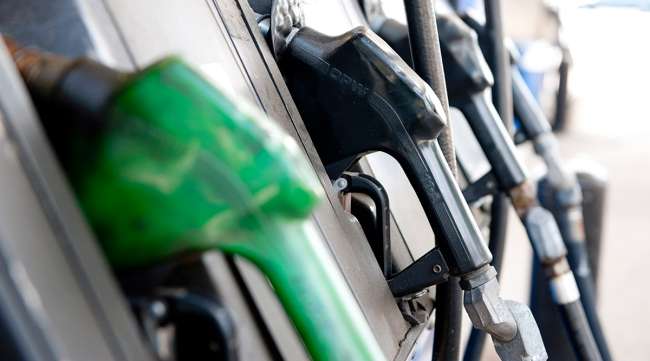Senior Reporter
Diesel Dips 0.2¢ to $3.062 a Gallon

[Stay on top of transportation news: Get TTNews in your inbox.]
The U.S. average retail price of diesel fell 0.2 cent to $3.062 a gallon, the Department of Energy reported Nov. 4.
Oil’s price climbed less than a dollar per barrel on suggestions a U.S.-China trade agreement appeared closer; although China reportedly seeks to have the U.S. cut the tariffs.
Trucking’s main fuel costs 27.6 cents less than it did a year ago, when it was $3.338 a gallon, according to DOE.
Regional average prices fell in five areas and rose in five.
The least expensive diesel was in the Gulf Coast region, at $2.795 a gallon. The most expensive was in California, at $4.011 a gallon.

In our first episode of RoadSigns, Season Four, we ask: What Does the Future Hold for Truck Platooning? Hear a snippet from Cetin Mericli, CEO and Founder of Locomation, above, and get the full program by going to RoadSigns.TTNews.com.
The average price of a gallon of gasoline rose 0.9 cent to $2.605 a gallon. The price is 14.8 cents less than it was a year ago.
Gasoline rose in all regions but two: It fell 1.5 cents a gallon to $2.230 in the Gulf Coast and was unchanged on the West Coast at $3.602.
In related news, American Transportation Research Institute reported fuel prices in 2018 accounted for a leading 17.7% of operational costs for fleets as the cost of fuel went from 36.8 cents per mile in 2017 to 43.3 cents in 2018.
Since February 2016, diesel generally has climbed, peaking in October 2018 at $3.394 a gallon, according to ATRI.
Gasoline prices moved in a similar direction in the period, which saw oil prices more than double.
On Feb. 5, 2016, West Texas Intermediate crude futures on the New York Mercantile Exchange closed at $30.89. They were $74.34 on Oct. 5, 2018.
Most recently, oil futures closed at $56.58 on Nov. 4 compared with $55.81 per barrel Oct. 28.
The average price of crude oil purchased by refiners accounted for 46% of the price of diesel most recently, EIA reported.
Meanwhile, a recent study found the newest, cleanest, near-zero-emission diesel truck engines, model year 2010 or newer, make up more than 40% of the U.S. fleet.
Now, nearly 43% of the almost 11 million Classes 3-8 diesel-powered commercial vehicles on U.S. roads are powered by the newest generation of diesel engines, the Diesel Technology Forum reported, citing data supplied by IHS Markit.
In 2015, the percentage of new-generation diesel trucks on America’s roads was 25.7%, according to the group. And growth jumped by 6.8% between December 2017 and July 2019.
“The emissions and fuel savings attributable to new-generation diesel engines in commercial trucks is astounding,” Diesel Technology Forum Executive Director Allen Schaeffer said. “They equate to making 26 million cars all-electric, eliminating the particulate matter emissions from all U.S. cars for 33 years, achieving carbon sequestration in a forest roughly the size of Texas, or creating a 27,000-turbine wind farm on land four times the size of Washington, D.C.”
Washington, D.C., encompasses 61 square miles.
According to the same data, 17 states are at or above the national average for the percentage of clean diesel Classes 3-8 commercial vehicles, and 15 states are growing their clean diesel fleets faster than the national average. Texas, Indiana and California rank highest in the total numbers of new Classes 3-8 commercial vehicles, the report found.
At the same time, one publicly traded national truck stop operation looked to expand locations despite what it called freight market headwinds.
“We continued to expand our travel center network during the third quarter, signing franchise agreements for three additional travel centers, bringing the total for 2019 to 10,” TravelCenters of America Inc. CEO Andrew Rebholz said.
In Q3, the company sold 431,336 gallons of diesel compared with 408,403 a year earlier, a 5.6% increase.
Meanwhile, “Oil prices are dancing to the upbeat U.S.-China trade tune,” PVM Oil Associates analysts Tamas Varga and Stephen Brennock wrote in a report. “A rally across global stock markets is acting as a boon for the energy complex.”
OPEC+ oil producers have slashed output by more than planned for months in an effort to tackle a looming oversupply. Yet a handful of countries continue to make that job harder, Bloomberg News reported. Iraq, Nigeria and Russia — OPEC’s largest ally — pumped above their quota in October, putting the onus on other members of the alliance to keep the market in balance as crude prices languished amid faltering demand. The group meets next in December.
Want more news? Listen to today's daily briefing:




